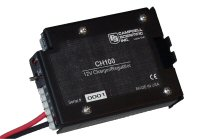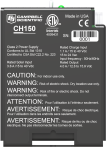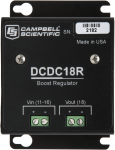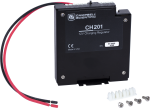This product is not available for new orders. We recommend ordering: CH150.

| Services Available |
|---|
Resumen
El CH100 es un regulador de carga para baterías recargables de 12Vdc. Este regulador incluye compensación en temperatura para optimizar el rendimiento de la batería. Se utiliza cuando es necesario utilizar una batería de 12Vdc pero de más de 7Ah.
Leer másImágenes










Ficheros CAD:
Descripción detallada
The CH100 regulator connects the BP12, BP24, or other sealed rechargeable battery to an external charging source (e.g., solar panel, wall charger). The circuitry of the CH100 is similar to the PS100, but the CH100 does not include a rechargeable battery. The rechargeable battery must be capable of accepting recharge from a trickle-charge source.
The CH100 controls the current flowing to the battery and prevents the battery current from flowing to the charging source.
Preguntas frecuentes
Número de FAQs relacionadas con CH100: 15
Expandir todoDesplegar todo
-
No. The CH100 is designed to charge a 12 Vdc battery pack, not a 24 Vdc battery pack.
-
Not quite. The PS24 consists of a 24 Ah battery, a CH100 regulator, and a 10 by 12 in. environmental enclosure. Aside from the enclosure, the PS24 is very similar to a BP24 combined with a CH100.
-
When the current from a solar panel is pushed through long, small-diameter cables, there is a voltage drop generated across the copper cables. This can be minimized by using shorter cables, if possible, or by using cable with a larger diameter (large-gauge wire). Some customers have successfully installed panels up to 50 and 100 ft away.
-
The CH100 has a built-in diode that only allows battery current to flow out of the battery to the 12 V and G terminals. But, because both loads are hooked up to the same battery, the system still drains the same. If there are two loads, and one is of a lesser priority than the other, the lower priority load can be controlled by connecting it to the SW12 on the data logger and turning it off if the battery voltage starts to get too low.
-
No. The CH100 will limit the current coming in from the 30 W panel to approximately 1.2 A, but it should not damage the regulator.
-
A better alternative is to purchase pn 17200, Battery Power Cable, 7 inches, or pn 22024, Battery Cable. Both cables include the plug that connects to the following regulators: CH100, CH200, PS100, and PS200. Using one of these cables ensures that the battery voltage is correct. This is because of the voltage drop across a diode that is between the battery terminals and the 12 V load terminals.
-
The BP24 should never be connected directly to an unregulated solar panel. A voltage regulator, such as the CH100, must be included in the circuit, or damage to the battery will occur.
-
With a solar panel connected, the quiescent current should be less than a 3 mA draw on the solar panel to light up the LED. (It does not consume current from the battery.) At night, the blocking diode blocks all measurable current from the battery. For power budget calculations, use 0 mA for the CH100 or PS100.
-
The PS100 (and CH100) are limited to 1.2 A of input. Because the SP20 20 W solar panel generates 1.17 A, that single panel represents a practical limitation to the input. For panels that generate current greater than 1.2 A, consider the PS200, Smart Power Supply and Charge Controller, or CH200, Smart 12 V Charging Regulator, for up to 3 A of input, or pn 18529, 10 A, 12 V, Morningstar Regulator, which is capable of accepting 10 A of input.
Generally, it is not recommended to connect more than one panel at a time. Differential shading can cause issues, such as the shaded panel acting as a current sink.
-
The red LED light on the CH100 or PS100 comes on whenever there is a working charging source connected. For example, if a solar panel is connected to the device, and the sun is shining, the LED light will turn on until the sun starts to go down. The red LED light should always be on when the device is connected to the wall transformer (when the ac power is present). Thus, the LED light is only a confirmation of power available to charge the battery.
If it is desirable to have an indication that the power switch is on, an LED light can be added to an unused control port on the datalogger and a program can be written to cause the LED light to blink every few seconds. Blinking the LED light once every few seconds will not put a large load on the battery, whereas a continuously lit LED draws down the battery more quickly.
Compatibilidad
Nota: lo siguiente muestra información de compatibilidad notable. No es una lista de todos los productos compatibles.
Miscelaneo
| Producto | Compatible | Nota |
|---|---|---|
| 34029 |
Información de compatibilidad adicional
Batteries
The CH100 is typically used with the BP12 and BP24 battery packs.
Especificaciones
| input Voltage (CHG Terminals) | 15 to 28 Vdc or 18 Vac RMS |
| Charging Output Voltage | Temperature-compensated float charge (for 12 Vdc battery) |
| Charging Current Limit | 1.2 A (typical) |
| Power Out (+12 Terminals) Voltage | Unregulated 12 Vdc from battery |
| Length of Red and Black Wires | ~30 cm (12 in.) |
| Dimensiones | 10.2 x 7.0 x 3.9 cm (4.0 x 2.8 x 1.5 in.) |
| Peso | 158 g (5.5 oz) |
Quiescent Current |
|
| Charge Source Present | 3 to 5 mA |
| No Charge Source Present | 0 mA |
Documentos
Folletos producto
Documentos técnicos
Casos de aplicación
In 2013, a sinkhole appeared next to a historic home in southern Louisiana. Over the......leer más
Currently, the Andean tropical glaciers are in an accelerated process of retreat. These glaciers are......leer más






